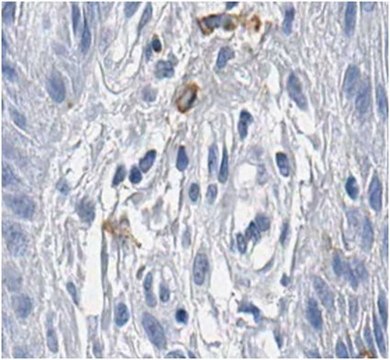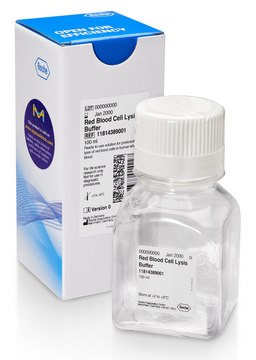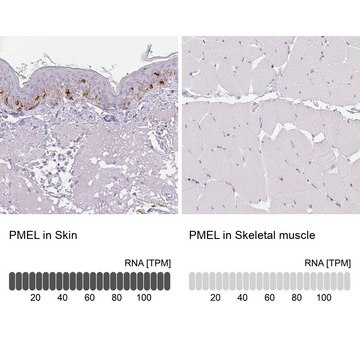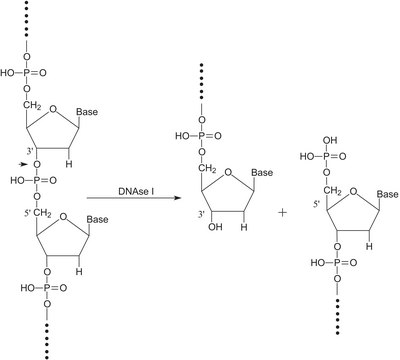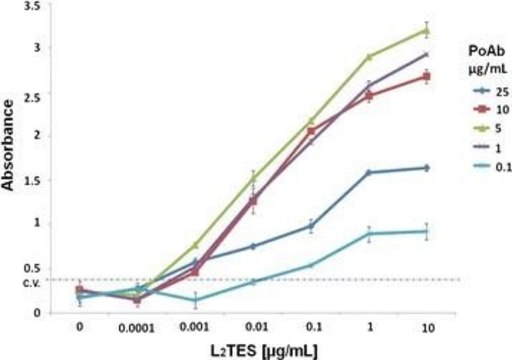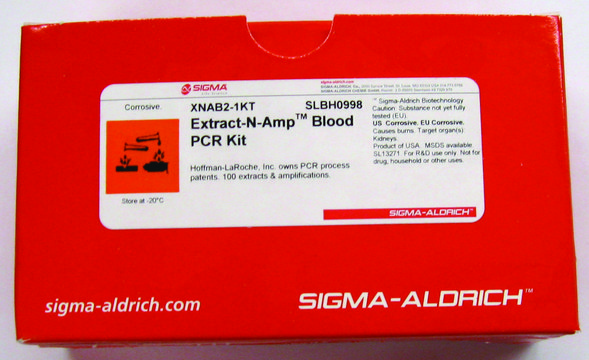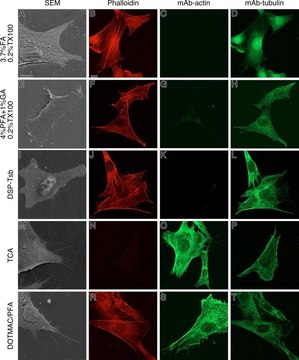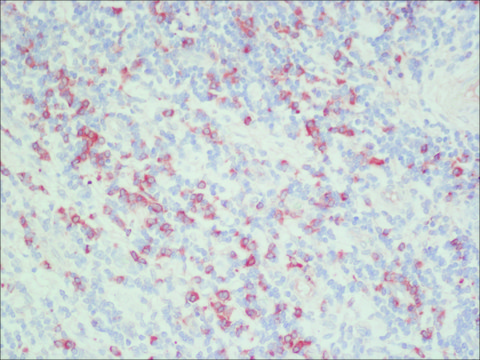SAB4200867
Anti-PMEL antibody produced in rabbit
affinity isolated antibody, buffered aqueous solution
Sign Into View Organizational & Contract Pricing
All Photos(3)
Synonym(s):
ME20-M (ME20M) Melanoma-associated ME20 antigen, Melanocyte protein, Melanocyte protein Pmel 17, Melanocytes lineage-specific antigen GP100, Melanoma gp100, P1, P100, Premelanosome protein, Silver locus protein homolog
UNSPSC Code:
12352203
NACRES:
NA.43
Recommended Products
antibody form
affinity isolated antibody
Quality Level
form
liquid
species reactivity
human
concentration
~1 mg/mL
technique(s)
immunoblotting: 1:1000-1:2000 using human melanoma SK-MEL-28 cell lysate
UniProt accession no.
shipped in
dry ice
storage temp.
−20°C
target post-translational modification
unmodified
General description
The melanocyte-specific protein PMEL (also known as Pmel17, gp100, melanocyte protein, premelanosome protein or silver locus protein homolog (SILV)) is a type I transmembrane glycoprotein that is expressed primarily in pigment cells of the skin and eye. In melanosomes, the protein forms a fibrillar matrix on which the UV-shielding pigment melanin is deposited.1-2
Specificity
Anti-PMEL antibody specifically recognizes human PMEL protein.
Application
The antibody may be used in various immunochemical techniques including Immunoblotting (~100 kDa), Immunohistochemistry and Immunofluorescence.
Detection of the PMEL band by Immunoblotting is specifically inhibited by the immunogen.
Detection of the PMEL band by Immunoblotting is specifically inhibited by the immunogen.
Biochem/physiol Actions
PMEL fibrils are a major functional component of the melanosomal compartment as they optimize melanin polymerization, condensation and storage.1,3
PMEL fibrils have an amyloidogenic nature and share features with pathological amyloids.4 Mutations in PMEL are associated with pigmentation disorders and/or impairments in eye development in various species.1,5,6
PMEL is suggested an excellent model system to study mechanisms of intracellular amyloid formation.1
PMEL fibrils have an amyloidogenic nature and share features with pathological amyloids.4 Mutations in PMEL are associated with pigmentation disorders and/or impairments in eye development in various species.1,5,6
PMEL is suggested an excellent model system to study mechanisms of intracellular amyloid formation.1
Physical form
Supplied as a solution in 0.01 M phosphate buffered saline pH 7.4, containing 15 mM sodium azide as a preservative.
Storage and Stability
For continuous use, store at 2-8°C for up to one month. For extended storage, freeze in working aliquots. Repeated freezing and thawing is not recommended. If slight turbidity occurs upon prolonged storage, clarify the solution by centrifugation before use. Working dilution samples should be discarded if not used within 12 hours.
Disclaimer
Unless otherwise stated in our catalog our products are intended for research use only and are not to be used for any other purpose, which includes but is not limited to, unauthorized commercial uses, in vitro diagnostic uses, ex vivo or in vivo therapeutic uses or any type of consumption or application to humans or animals.
WGK
WGK 1
Regulatory Information
常规特殊物品
Certificates of Analysis (COA)
Search for Certificates of Analysis (COA) by entering the products Lot/Batch Number. Lot and Batch Numbers can be found on a product’s label following the words ‘Lot’ or ‘Batch’.
Already Own This Product?
Find documentation for the products that you have recently purchased in the Document Library.
Christin Bissig et al.
International journal of molecular sciences, 17(9) (2016-09-03)
In pigment cells, melanin synthesis takes place in specialized organelles, called melanosomes. The biogenesis and maturation of melanosomes is initiated by an unpigmented step that takes place prior to the initiation of melanin synthesis and leads to the formation of
Thomas Burgoyne et al.
Journal of cell science, 128(7), 1400-1407 (2015-02-19)
Analysis of melanosome biogenesis in the retinal pigment epithelium (RPE) is challenging because it occurs predominantly in a short embryonic time window. Here, we show that the zebrafish provides an ideal model system for studying this process because in the
Douglas M Fowler et al.
PLoS biology, 4(1), e6-e6 (2005-11-23)
Amyloid is a generally insoluble, fibrous cross-beta sheet protein aggregate. The process of amyloidogenesis is associated with a variety of neurodegenerative diseases including Alzheimer, Parkinson, and Huntington disease. We report the discovery of an unprecedented functional mammalian amyloid structure generated
Jia Shee Hee et al.
Scientific reports, 7, 44064-44064 (2017-03-09)
PMEL is a pigment cell protein that forms physiological amyloid in melanosomes. Many amyloids and/or their oligomeric precursors are toxic, causing or contributing to severe, incurable diseases including Alzheimer's and prion diseases. Striking similarities in intracellular formation pathways between PMEL
Helia B Schonthaler et al.
Developmental biology, 284(2), 421-436 (2005-07-19)
Forward genetic screens have been instrumental in defining molecular components of visual function. The zebrafish mutant fading vision (fdv) has been identified in such a screen due to defects in vision accompanied by hypopigmentation in the retinal pigment epithelium (RPE)
Our team of scientists has experience in all areas of research including Life Science, Material Science, Chemical Synthesis, Chromatography, Analytical and many others.
Contact Technical Service
